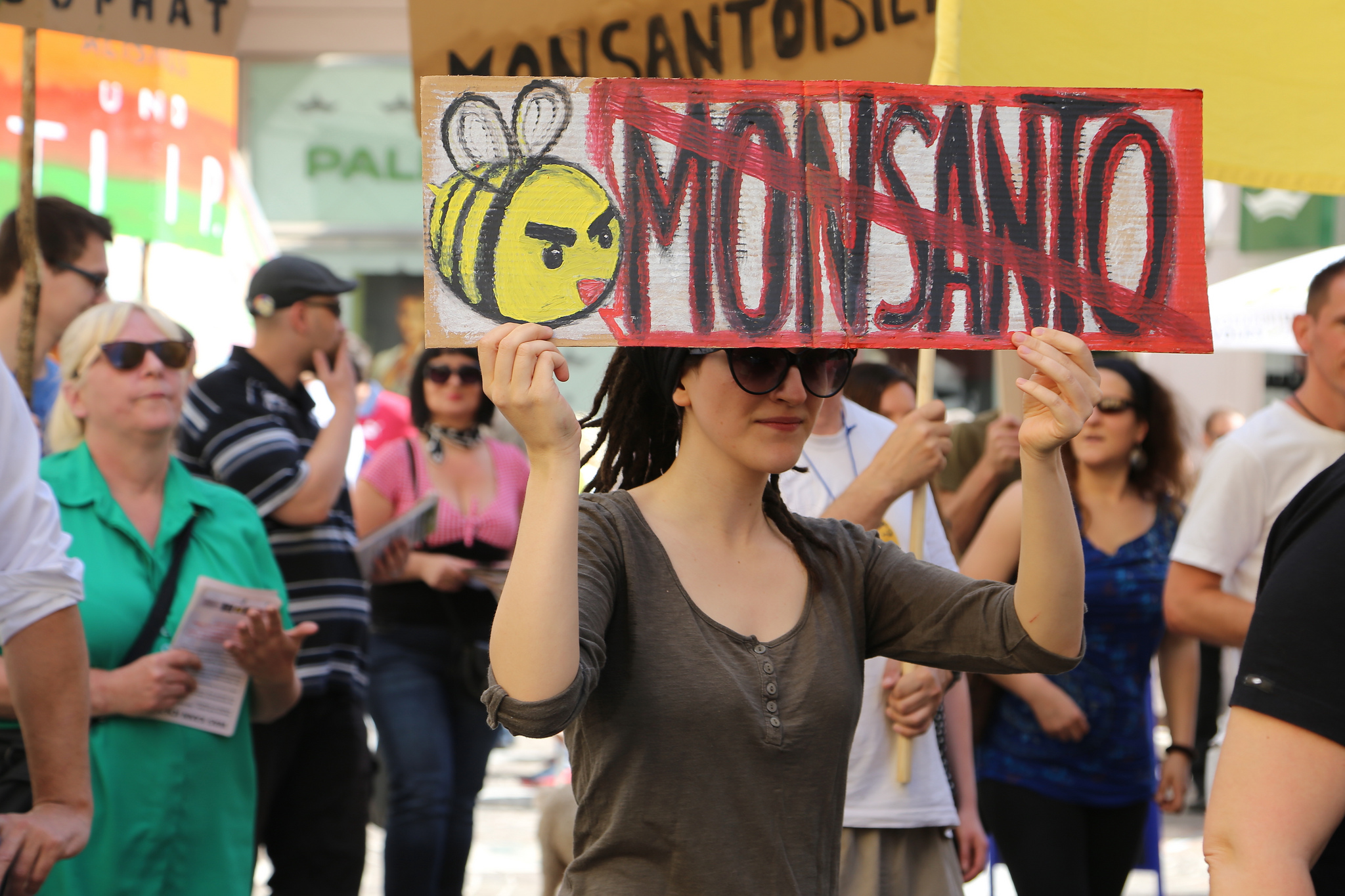Biotechnology is going through one of the fastest developments in the century, particularly in the field of genetic modifications. While genetic modification has been well accepted in medicine and pharmacy, genetically modified food is causing one of the greatest global debates to date. The innovation, developed to tackle global famine and climate change, is still a largely unknown concept that can cause potential risk on the environment and human health. Both animal and plant genetic modification have therefore been brought into a social context, affecting many economic, ethical as well as environmental areas.
IN THE PHOTO: BIOTECHNOLOGY LABORATORY. PHOTO CREDIT: FLICKR/MARYLAND GOVPICS
Some countries welcomed the innovation, some started to protect themselves from it – as did Slovenia, a nation state situated in Central and Southeastern Europe, touching the Alps and bordering the Mediterranean.
IN THE PHOTO: SLOVENIA. THE COUNTRY TOTALS 2.0 MILLION HECTARES; NEARLY 40 % IS USED FOR AGRICULTURE – OF THE AGRICULTURAL AREA, MORE THAN 60 % IS PERMANENT PASTURE AND SOME 30 % IS ARABLE. PHOTO CREDIT: FLICKR/JAMES SOUTHORN
Before identifying the reasons why and how Slovenia protected itself, we need to understand the general concept of genetically modified food, and its impact in the world. Soon after scientists first discovered that DNA could be transferred between organisms, they began working on genetic modification. First it was used in medicine and pharmacy, and in time, with the growing population and scarcity of natural resources, it became an innovative solution for agriculture, environment and food industry.
The official definition of Genetically Modified Food as provided by the World Trade Organization (WTO) states that genetically modified (GM) foods are foods derived from organisms whose genetic material (DNA) has been modified in a way that does not occur naturally, e.g. through the introduction of a gene from a different organism.
The first genetically modified plant was produced in 1983 in China, using an antibiotic-resistant tobacco plant. Now, 40 years later, farmers have the ability to choose from a variety of modified commercial crops and seeds. The most popular are crops with resistance to herbicides, pests and viruses. At this point in time (June 2016), genetically modified products – the most popular are maize, cotton, soybean, papaya – are legalized for commercial use in 28 countries and the biggest producers are USA, Brazil, Argentina, India, Canada and China.
Related article: “THE BATTLE FOR FOOD“
The closest Slovenian agriculture got to the potential production of genetically modified crops was in the year 2013, when corn bugs attacked huge swathes of corn fields. At that time the Biotechnological institute in Slovenia was conducting experiments on corn MON810 with resistance to herbicides and insects (bugs) and they suggested the genetically modified option to farmers.

IN THE PHOTO: GENETICALLY MODIFIED CORN PRODUCTION HAS EXPANDED TO MORE THAN 35 MILLION HECTARES WORLDWIDE – ABOUT 80 PER CENT OF THE CORN NOW PRODUCED IN THE US IS GENETICALLY MODIFIED. TWO TRAITS ARE EXPRESSED BY TODAY’S GM CORN CULTIVARS: INSECT RESISTANCE AND HERBICIDE TOLERANCE. PHOTO CREDIT: FLICKR/SHILPA AGGARWAL
However there were many reasons why the project ended in the early stages, and those reasons clearly reflect the views of opposition in a global debate about genetically modified food. Yet it is important not to forget the benefits as well.
Economic View
One of the benefits with growing genetically modified food is improved effectiveness in agriculture and higher revenue. The production is cheaper and the number of products can increase because of resistance to insects, high tolerance to herbicides and better resilience to uncertain weather conditions. Even though Slovenian farmers faced huge losses of corn due to the corn bug, economically they were still managing to cover for the loses.
Since the situation was not so bad, more a shock than an outright disaster, farmers decided not to use the genetically modified alternative, even though they might have had economic benefits.
The production of corn in Slovenia is so small, it would not have increased returns to farmers by that much, and let’s not forget the powerful aspect of consumers’ distrust for genetically modified products.
Not to mention that farmers would have had to wait for a long time to get application approval from the European Union to grow the genetically modified alternative. For them it was more practical to wait for another year, and see if the threat would reappear. Luckily it did not.
But if we look at the developing and underdeveloped countries with very unreliable climate and large problems of poverty, the genetically modified crops could be a highly valuable solution. Unfortunately, even though the greatest agricultural genetic diversity is found in tropical zones, the tools of modern technology are mostly found in temperate zones. Private corporations and research institutions who own and use the tools, are failing in making arrangements to share genetic engineering technology with responsible scientists for alleviating hunger in developing countries.
Moreover, the technology is now held under strict patents and licensing agreements. Therefore if a country wants to grow genetically modified crops, it first needs to pay an extremely high price for using the crops and then carefully control the use of it, so that food safety, public health and the environment aren’t exposed to any danger.
 IN THE PHOTO: PROTESTS AGAINST MONSANTO, ONE OF THE BIGGEST AGROCHEMICAL AND AGRICULTURAL BIOTECHNOLOGY COOPERATION THAT PRODUCES GENETICALLY MODIFIED FOODS AND SEEDS, DRUGS, PESTICIDES AS WELL AS HERBICIDES. PROTESTS ARE HAPPENING ON A DAILY BASIS SINCE PEOPLE BELIEVE THAT MONSANTO’S GENETICALLY MODIFIED FOOD IS POISONOUS. ANOTHER NOTABLE FACT: MONSANTO IS THE WORLDS LARGEST SEED COMPANY, IT DOMINATES THE GLOBAL MARKET AND OWNS 91% OF ALL GENETICALLY MODIFIED CROPS IN THE WORLD. PHOTO CREDIT: FLICKR/DIE GRÜNEN KÄRNTEN
IN THE PHOTO: PROTESTS AGAINST MONSANTO, ONE OF THE BIGGEST AGROCHEMICAL AND AGRICULTURAL BIOTECHNOLOGY COOPERATION THAT PRODUCES GENETICALLY MODIFIED FOODS AND SEEDS, DRUGS, PESTICIDES AS WELL AS HERBICIDES. PROTESTS ARE HAPPENING ON A DAILY BASIS SINCE PEOPLE BELIEVE THAT MONSANTO’S GENETICALLY MODIFIED FOOD IS POISONOUS. ANOTHER NOTABLE FACT: MONSANTO IS THE WORLDS LARGEST SEED COMPANY, IT DOMINATES THE GLOBAL MARKET AND OWNS 91% OF ALL GENETICALLY MODIFIED CROPS IN THE WORLD. PHOTO CREDIT: FLICKR/DIE GRÜNEN KÄRNTEN
Social View
Having enough food is a basic human need and we are morally obliged to fight world famine – which brings us to agricultural development.
Let’s assume, as a thought experiment, that the tools which are producing genetically modified foods are holding the potential to address adaptation to environmental conditions and tackle all the nutrition problems and satisfy the dietary needs to solve world famine.
A brilliant example (one of many) of such a genetically modified crop is “Golden Rice”: Grains of rice have turned the color of gold because they have been modified to produce enough beta-carotene to a meet person`s daily requirements of vitamin A. But the general opinion is that we should rather look at already available (read – safer) solutions to address the deficiency of A vitamin.
For a full mindmap behind this article with articles, videos, and documents see #food
Genetically modified food is a “novel” product and it is feared that, when released, it could cause genetic “pollution” and damage human health. Until now numerous laws and regulations have been passed to protect the uncertainty people are facing with this kind of food.
One problem with this view is that determining food safety is never simple: “Safe” implies a value judgment that potential hazards have been adequately analyzed and that any remaining risks are “acceptable”. That is the essence of the “precautionary principle” to which the European Union is deeply attached.
One approach, which is being used in assessing the risks of genetically modified food, derives from the concept of “substantial equivalence”. It acknowledges that the goal of the assessment is not to establish absolute safety but to consider whether or not GM food is as safe as its traditional counterpart (if the counterpart exists).
 IN THE PHOTO: MORE PROTEST. ASSESSMENT OF GM CROPS REQUIRES A STEP-BY-STEP APPROACH WHERE DIFFERENT FACTORS NEED TO BE TAKEN IN ACCOUNT: I) IDENTITY, SOURCE AND COMPOSITION; II) EFFECTS OF PROCESSING AND COOKING; III) THE TRANSFORMATION OF DNA; IV) EFFECTS ON FUNCTION; V) POTENTIAL TOXICITY, POTENTIAL ALLERGENCITY; VI) POTENTIAL INTAKE. IF THE GM FOOD IS EQUIVALENT TO ITS CONVENTIONAL COUNTERPART, IT CAN BE CONSIDERED AS SAFE. (FAO, 2001). PHOTO CREDIT: FLICKR/OCCUPY RENO MEDIA COMMITTEE
IN THE PHOTO: MORE PROTEST. ASSESSMENT OF GM CROPS REQUIRES A STEP-BY-STEP APPROACH WHERE DIFFERENT FACTORS NEED TO BE TAKEN IN ACCOUNT: I) IDENTITY, SOURCE AND COMPOSITION; II) EFFECTS OF PROCESSING AND COOKING; III) THE TRANSFORMATION OF DNA; IV) EFFECTS ON FUNCTION; V) POTENTIAL TOXICITY, POTENTIAL ALLERGENCITY; VI) POTENTIAL INTAKE. IF THE GM FOOD IS EQUIVALENT TO ITS CONVENTIONAL COUNTERPART, IT CAN BE CONSIDERED AS SAFE. (FAO, 2001). PHOTO CREDIT: FLICKR/OCCUPY RENO MEDIA COMMITTEE
In the example of Slovenia, the exceptional hype created by the national media around GM foods played an essential role in shaping the public view on genetically modified crops. Arguments mainly revolved around the question of whether GM foods presented potential danger to people and the environment and should therefore not be allowed on the market. Naturally consumers were affected by the media, and their reaction negatively impacted food demand.
As a result, farmers had no choice but to stick to the natural crop.
Environmental Concerns
As any genetically modified organism enters the environment, they present a threat to the ecosystems and agro-ecosystems. The flow of genes has to be considered and therefore the countries that produce GM crops must follow detailed monitoring of the fields as well as maintaining distance between GM crops and natural crops to ensure a “safety belt” is created.
But consider the alternative: If all the necessary precautions were properly met, the environment could also benefit from the growth of genetically modified crops.
Farmers would stop using so much chemicals and as a result the soil and water would be less polluted. Not to mention the crops would have a higher yield.
Yet this can only be applied in the larger flat lands so it is no wonder that the biggest countries in the world, in terms of farmland, actually do grow genetically modified crops.
On the contrary Slovenia is one of the countries that has the smallest farmland surface area per capita in Europe (0,86 hectares). Which means it has inappropriate partition of agricultural estate structure. The small estates and farms with little numbers of field crops are much more susceptible to unwanted pollination.
With additional imposition of a 600-meter safety belt, it is almost impossible in Slovenia to grown GM crops and have good control over it.
Also another source of worry: Many experiments with the modified crops showed negative effect of herbicide resistant crops on non-target organisms (especially good and beneficial insects) such as ladybugs, bees and butterflies.
IN THE PHOTO: MONARCHS (DANAUS PLEXIPPUS), MIGRATORY LEPIDOPTERA THAT FEED ON MILKWEEDS, ARE THE BEST-KNOWN BUTTERFLIES IN NORTH AMERICA. A WELL-PUBLICIZED STUDY OF GMOS SHOWED THAT BT MAIZE POLLEN WAS TOXIC TO LABORATORY-FED MONARCH BUTTERFLY LARVAE. A STUDY LATER COLLECTED POLLEN-COVERED MILKWEED PLANTS, WHICH WERE FOUND GROWING NATURALLY NEXT TO BT MAIZE FIELDS. A SIGNIFICANTLY LARGER PROPORTION OF MONARCH BUTTERFLY LARVAE THAT FED ON THESE FIELD-COLLECTED PLANTS DIED COMPARED WITH THOSE FED POLLEN-FREE PLANTS. PHOTO CREDIT: FLICKR/CAPTAIN-TUCKER
Trend is “organic”
The biggest current agriculture trend in Europe and Slovenia is organic farming.
In 2003, a declaration on »Ecoregion Alpe Adria« has been signed by the presidents of organic farmers’ associations of Slovenia, the Austrian provinces of Carinthia and Styria and the Italian provinces of Friuli-Venezia Giulia and Veneto, expressing their intention to work towards an organic and trans-boundary GMO-free region.
Within its agri-environmental program, Slovenia has allocated $12,3 million to supporting various measures including organic agriculture, integrated pest management (IPM) for fruit, vine and vegetable production, extensification of crop production and animal rearing, hand-mowing of grass and breeding of indigenous, traditional crops, such as spelt wheat and buckwheat.
As we saw in the example of Slovenia, the ability to grow genetically modified crops is next to impossible. The majority of other European countries face a similar situation as well. Global green initiative still believes that modified products are dangerous and now more then 80% of all countries in the world urge to label those products.
It is hard to pick sides in this very controversial matter.
The fact still remains that, for now, this might be the quickest solution to fight famines and weather changes. Yet is it the best solution? I cannot tell. The moment we are working with changing genes, everything becomes very unnatural and a bit out of ordinary. What I do believe is that we will be hearing about genetically modified foods for many years to come, hopefully up to the point where we will have enough proof to determine if it is dangerous or not.
Recommended reading: “THREE WAYS TO TRANSFORM AGRICULTURE IN AFRICA“
_ _
EDITOR’S NOTE: The opinions expressed here by Impakter.com columnists are their own, not those of Impakter.com.
Impakter article about GMOs in Slovenia Instagram.com















